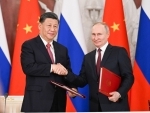Canada: NASA’s MAVEN spacecraft detects metal ions in upper atmosphere
Joseph Grebowsky is the lead author of a paper on the topic which was published in Geophysical Research Letters.
Grebowsky, of NASA's Goddard Space Flight Center, Maryland explained that metallic ions originating from earth get transported to the planets by neutral winds and electric fields and can be used to infer motion in the ionosphere, similar to the inference of the lofted leaf to predict the direction of blowing wind.
This revelation throws further light on MAVEN’s exploration of the Martian upper atmosphere (ionosphere) to understand how ionospheric activity in Martian atmosphere is being absorbed in space, according to the team.
When these meteoroids, which are the source of the metals on the planet, hit the Martian atmosphere, it vaporizes. Metal atoms in the vapor get charged by other charged atoms and molecules in the ionosphere and are transformed to electrically charged ions.
Using its Neutral Gas and Ion Mass Spectrometer instrument, MAVEN detected iron, magnesium, and sodium ions in the upper atmosphere of Mars over the past two years and the team was confident that the metal ions were a permanent feature, said Grebowsky
The team said that there was a probability that all solar system planets and moons with substantial atmospheres have metal ions.
However, detection of the metal ions by MAVEN is the first conclusive evidence of permanent existence of these ions on another planet.
The team found that the metal ions behaved differently on Mars and Earth. Earth is surrounded by a global magnetic field generated in its interior, which, together with ionospheric winds, forces the metal ions into layers.
Mars had only local magnetic fields concentrated in certain regions of its crust, and the team only saw the layers of metals near these areas, said Grebowsky.
Detailed understanding of the difference of behaviours of meteoritic ions in Earth and Mars will be useful for better predicting of impact which these interplanetary dust would have on other unexplored solar system atmospheres, said Grebowsky.
The research was funded by the MAVEN mission and MAVEN project was managed by NASA Goddard.
(Reporting by Asha Bajaj)
Support Our Journalism
We cannot do without you.. your contribution supports unbiased journalism
IBNS is not driven by any ism- not wokeism, not racism, not skewed secularism, not hyper right-wing or left liberal ideals, nor by any hardline religious beliefs or hyper nationalism. We want to serve you good old objective news, as they are. We do not judge or preach. We let people decide for themselves. We only try to present factual and well-sourced news.







